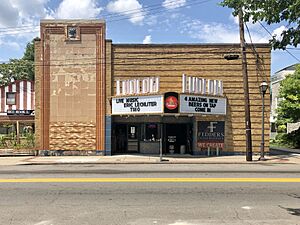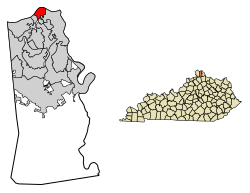Ludlow, Kentucky facts for kids
Quick facts for kids
Ludlow, Kentucky
|
|
|---|---|

Old Ludlow Theatre
|
|

Location of Ludlow in Kenton County, Kentucky.
|
|
| Country | United States |
| State | Kentucky |
| County | Kenton |
| Incorporated | 1864 |
| Named for | Israel Ludlow |
| Area | |
| • Total | 1.28 sq mi (3.31 km2) |
| • Land | 0.92 sq mi (2.37 km2) |
| • Water | 0.36 sq mi (0.93 km2) |
| Elevation | 545 ft (166 m) |
| Population
(2020)
|
|
| • Total | 4,385 |
| • Estimate
(2022)
|
4,343 |
| • Density | 4,787.12/sq mi (1,849.06/km2) |
| Time zone | UTC-5 (Eastern (EST)) |
| • Summer (DST) | UTC-4 (EDT) |
| ZIP code |
41016
|
| Area code(s) | 859 |
| FIPS code | 21-48378 |
| GNIS feature ID | 2404969 |
Ludlow is a city in Kenton County, Kentucky, located right next to the Ohio River. In 2020, about 4,385 people lived there. It's a smaller city near the bigger city of Cincinnati. Ludlow grew a lot in its early days because it was an important train stop.
Contents
A Look Back: Ludlow's History
How Ludlow Began
In 1790, the land where Ludlow now stands was given to Thomas Sandford. He was a general who served in the American Revolutionary War. Sandford later traded this land to Thomas D. Carneal.
Carneal built a large house called Elmwood Hall in 1818. This house is still standing today at 244 Forest Avenue. Later, Carneal sold the land to William Bullock, a traveler from Britain. Bullock wanted to build a special community there called Hygeia, which means "health" in Greek. However, his plan never happened.
In 1830, Bullock sold the land to Israel L. Ludlow. The town of Ludlow was officially planned out in 1846. The city of Ludlow, named after Israel L. Ludlow, became an official city in 1864.
Growth and the Railroad
When the Cincinnati Southern Railroad arrived in the 1870s, Ludlow became very popular. Many people, especially from Germany and Ireland, moved to Ludlow because there were lots of jobs on the railroad.
In the 1890s, a streetcar service called The Green Line also made Ludlow more popular. This helped the city grow even more.
The Ludlow Lagoon Amusement Park
Building a Fun Place
Near the border of Bromley, Kentucky, which is west of Ludlow, a big lake was built in 1894. This was done by The Green Line streetcar company. They wanted to create an amusement park at the end of their streetcar line in Ludlow.
The lake was 85 acres and had five islands. It opened in 1895 and was first used for fishing and boating. Soon, more fun things were added, like a clubhouse for dining and a dance hall. Many popular music groups played there during the Jazz Age.
Rides and Attractions
Over time, the Ludlow Lagoon added many classic amusement park rides. The most famous was the Scenic Railway, a roller coaster that went across the lake. It was designed by LaMarcus Adna Thompson, who also designed a similar ride at Coney Island in New York.
Other attractions included an amphitheater, a movie theater, a stage for live shows, and a Japanese-themed fair. The park also had walking trails, games, acrobats, and other performers. By the early 1900s, thousands of people visited the park every day.
A motorcycle racetrack called the Ludlow Motordrome opened on July 21, 1913. It could hold 8,000 people and attracted huge crowds.
Challenges and Closing
Just before the motordrome was built, a big flood in 1913 damaged many parts of the park. Then, only nine days after the motordrome opened, a terrible accident happened on July 30, 1913. A motorcycle crashed, causing a fire in the stands. This accident killed at least ten people and injured over one hundred others.
Two years later, in July 1915, a tornado hit Ludlow. It damaged many buildings and attractions at the Lagoon, causing a lot of money in damage.
The final reason the Lagoon closed was World War I. The U.S. Government needed grain for the war, so they limited how much beer could be made. Since the Lagoon sold a lot of local beer, this hurt their business. The Ludlow Lagoon closed after the 1917 season. Today, the lake has been filled in, and all the rides are gone. Only the clubhouse still stands at 312 Lake St.
Ludlow After the Wars
After World War I, Ludlow started to grow again, even after the Lagoon closed. New neighborhoods were added, and the old amusement park area was redeveloped.
Ludlow also did well after World War II. Many babies were born during the "Baby Boom," and the population grew to 6,374 by 1950. This meant more people for churches and schools. New homes were built in an area called Ludlow Heights.
However, in the 1960s, the population started to shrink and has been declining since then. In recent years, Ludlow has made some small improvements, especially to its homes.
Geography and Land
Ludlow is about 1.2 square miles in total size. About 0.9 square miles of this is land, and 0.4 square miles is water. This means a good part of the city's area is covered by water, mostly from the Ohio River.
People of Ludlow
| Historical population | |||
|---|---|---|---|
| Census | Pop. | %± | |
| 1890 | 2,469 | — | |
| 1900 | 3,334 | 35.0% | |
| 1910 | 4,163 | 24.9% | |
| 1920 | 4,582 | 10.1% | |
| 1930 | 6,485 | 41.5% | |
| 1940 | 6,185 | −4.6% | |
| 1950 | 6,374 | 3.1% | |
| 1960 | 6,233 | −2.2% | |
| 1970 | 5,815 | −6.7% | |
| 1980 | 4,959 | −14.7% | |
| 1990 | 4,736 | −4.5% | |
| 2000 | 4,409 | −6.9% | |
| 2010 | 4,407 | 0.0% | |
| 2020 | 4,385 | −0.5% | |
| 2022 (est.) | 4,343 | −1.5% | |
| U.S. Decennial Census | |||
In 2000, there were 4,409 people living in Ludlow. There were 1,739 households, which are groups of people living together.
About 33.9% of households had children under 18. The average household had about 2.54 people. The average family had about 3.18 people.
The city's population was spread out by age. About 28.8% were under 18, and 12.2% were 65 or older. The average age in Ludlow was 34 years old.
Most people in Ludlow are White (98.46%). A small number of people are African American, Native American, Asian, or from other backgrounds. About 0.75% of the population was Hispanic or Latino.
Education
Most of Ludlow is part of the Ludlow Independent School District. A small part of the city is in the Covington Independent School District.
Images for kids
See also
 In Spanish: Ludlow (Kentucky) para niños
In Spanish: Ludlow (Kentucky) para niños



